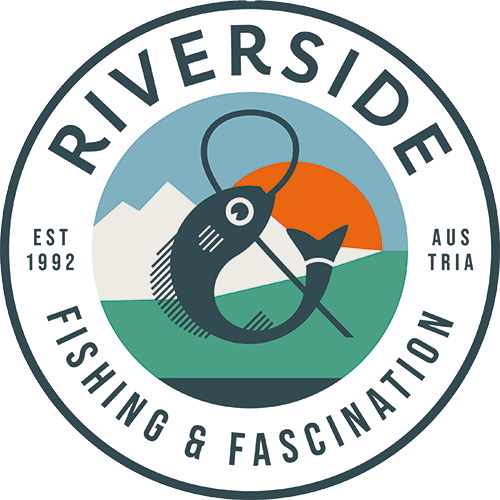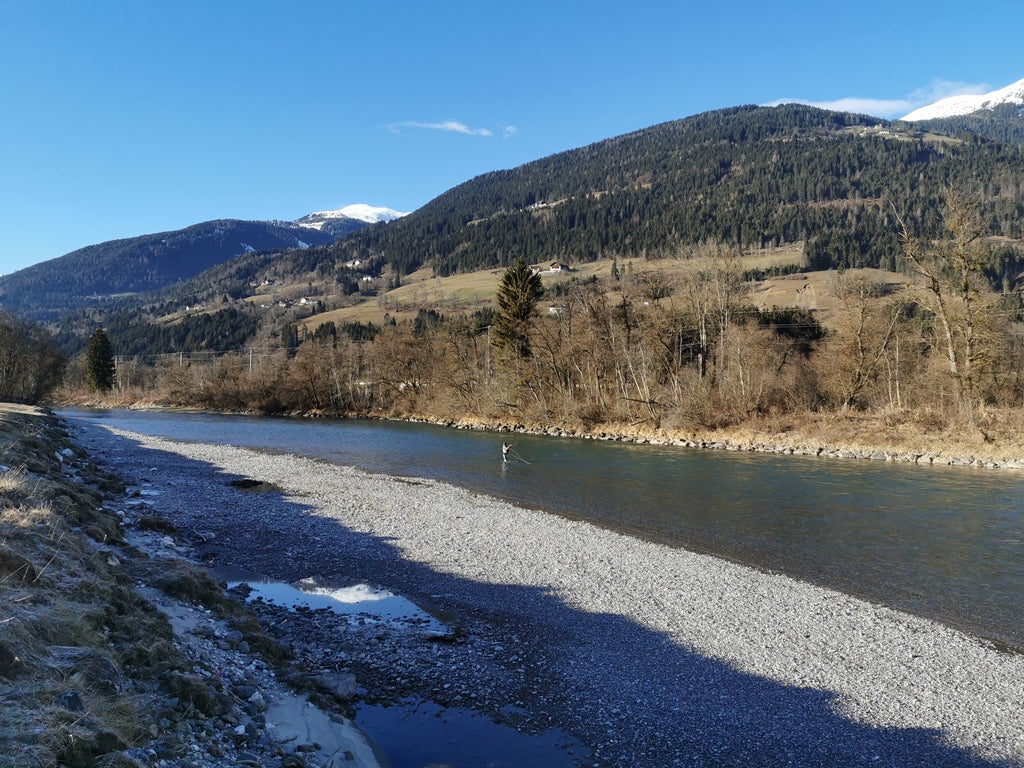Es gibt auf der Welt Orte, die einen ganz besonderen Reiz haben, Orte, die Emotionen hervorrufen, Erinnerungen wecken und vor Geschichte nur so strotzen. Legendäre Orte, die sofort mit bestimmten Ereignissen oder besonderen Situationen verbunden werden: Monza für den Motorsport, Wimbledon für Tennis und so weiter. Auch in der Welt des Angelns haben wir unsere heiligen Tempel: der River Test in England, der Sesia in Italien, der Gacka in Kroatien, der Gallatin in Montana, und die Liste ist endlos. Auf persönlicher Ebene – und sicherlich nicht nur meiner Ansicht nach – ist der Fluss Drau in Österreich für das Äschenfischen definitiv ein legendärer und faszinierender Ort. Ein schwieriger Fluss, vor allem wenn man ihn nicht gut kennt, der selbst erfahrene Angler oft leer ausgehen lässt, aber auch großartige, wilde Fische belohnen kann. Einen Fisch hier zu fangen, bringt doppelte Zufriedenheit!

Drau – „Die Heimat der Äsche“
Bereits seit den 1970er Jahren war der Abschnitt der Drau zwischen Osttirol und Kärnten ein beliebtes Ziel vieler europäischer, insbesondere italienischer Angler. Zu den Pionieren des Äschenfischens gehörte auch mein Großvater Francesco, der mit seinen Fliegen praktisch jede Reserve und jeden Zufluss der Drau befischte und sowohl meinem Vater als auch mir die Liebe zu diesem Fluss und seinen Schätzen weitergab.
Der obere Lauf der Drau, bis zur Stadt Spittal und etwas darüber hinaus, bietet ein perfektes Habitat für Äschen. Leider hat sich dieser Abschnitt in den letzten Jahrzehnten stark verändert, sowohl durch menschliche Eingriffe, wie den Bau von Staudämmen und Ufern, als auch durch die Auswirkungen des Klimawandels. Diese Faktoren führen zu höheren Wasserständen durch das Schmelzen der Gletscher und zu heftigen Hochwassern aufgrund von Starkniederschlägen. Dennoch hat die Drau eine gute Population von Äschen, die hauptsächlich aus großen, erwachsenen Exemplaren besteht. Es ist selten, kleine Äschen zu fangen, da sie zusammen mit Regenbogenforellen auch das Hauptfutter für die großen Huchen bilden, die diesen Fluss bevölkern.


Francesco Gargantini Sen., regelmäßiger Besucher der österreichischen Gewässer seit den 1970er Jahren, und die klaren Gewässer der Drau
Die Reserve der GROßEN FISCHE
Was mich an diesem Fluss besonders fasziniert, ist die Ungewissheit darüber, was man an den Haken bekommt (in Bezug auf die Größe der Äschen). Für jemanden wie mich, der auf große Fische aus ist, ist dieser Ort ideal, um die magische 50-cm-Marke zu überschreiten. Da ich die Reserven, die ich mit meiner Familie verwalte, gut kenne, kann ich die besten Stellen und Pools sondieren, in denen sich die großen Fische verstecken. Wie alle österreichischen Flüsse ist auch die Drau in private Reserven aufgeteilt, und zum Fischen benötigt man immer spezielle Genehmigungen. Es ist besser, sich vorher zu informieren, um unangenehme Überraschungen wie Geldstrafen oder sogar Anzeigen zu vermeiden. Verschiedene private Abschnitte der Drau stehen den Gästen des Aktiv Hotels und den Mitgliedern des Grayling Trophy Clubs zur Verfügung. In diesen Reserven wurden bereits zwei IGFA-Weltrekorde für Äschen aufgestellt, und ich bin sicher, dass bald der dritte folgen wird!
Der erste Teil der Saison endete mit einem Anstieg der Pegelstände, verursacht durch das Schmelzen des Schnees und des Gletschers am Großglockner. In der Regel ist das Fischen von der Eröffnung am 1. April bis etwa Mitte Mai gut, danach „ruhen“ der Fluss und die Fische bis September, um uns dann den ganzen Herbst über zu unterhalten. Glücklicherweise war der Frühling wenig regnerisch, und das Schmelzen der Gletscher verlief moderat, was den Laichprozess der Äschen erfolgreich abschloss. Die Ergebnisse werden wir bald sehen.

Äschen so groß wie Karpfen
Also „Wenige, aber große“…
Rekord-Äschenfischen. Ja, man muss sich von Anfang an bewusst sein, dass jeder Fisch erkämpft werden muss. Die Drau schenkt nichts – jeder Fang, ob kleine Äsche oder großer Huchen, muss hart erarbeitet werden. Beim Fischen in der Drau liegt der Fokus eher auf Qualität als auf Quantität. Die sorgfältige Auswahl der Imitationen, Konzentration und viel Geduld sind der Schlüssel zum Erfolg. Konzentration ist besonders wichtig: Man muss die Nymphen im Wasser spüren, den Fluss lesen können und die verschiedenen Situationen verstehen, die sich einem bieten. Gelegentlich ist ein leichter Zupfer an der Leine ein Zeichen für einen großen Fisch, der den Tag – oder sogar das Leben – verändern kann.
Je nach Jahreszeit und Wetterbedingungen kann man in der Drau alle Hauptvarianten des Fliegenfischens praktizieren. Die Nymphenfischerei dominiert hier und ermöglicht es, das Potenzial dieses Flusses in verschiedenen Situationen voll auszuschöpfen. Moderne Nymphentechniken, die unsere Art zu fischen grundlegend verändert haben, sind perfekt für die Drau. Tschechische Nymphe mit 2 oder 3 Nymphen, Nymphen mit Faden oder mit Indikator – eine robuste Rute für Schnurklasse 4 oder 5, mindestens 3 Meter lang, ist ideal, um einen Fluss mit einer durchschnittlichen Wasserführung von 25 bis 30 m³ pro Sekunde zu befischen und den Sprüngen und Fluchten der großen Fische standzuhalten. Die Imitationen, die wir normalerweise verwenden, sind auf relativ großen Haken gebunden, Größe 14 und 12, manchmal sogar 10. Es hängt davon ab, was wir imitieren möchten und in welcher Jahreszeit wir fischen. Die Nymphen, die man unbedingt dabeihaben sollte, sind Eintagsfliegenlarven mit Fasanenschwanz, Köcherfliegen-Imitate und Perdigones – alle mit Tungstenperlen oder -körpern, um die tiefsten Pools an den Felsen zu durchsuchen, wo sich die großen Fische verstecken.


Die legendäre „Gummy Nymph“, die beste Fliege für die Äschen der Drau und darüber hinaus. Die „Snack“ ist eine vielseitige Fliege, sowohl zum Jagen als auch für den Schlüpfprozess.
 Bei Schlüpfen und Oberflächenaktivität kann selbst der leidenschaftlichste Nymphenfischer für eine Weile „die dunkle Seite des Fliegenfischens“ aufgeben und sich dem Trockenfliegenfischen widmen, was ebenfalls große Fänge bringen kann. Besonders im Herbst und in den mittleren Stunden des Tages kann man auf große Schlüpfe von Baetis-Eintagsfliegen und Köcherfliegen stoßen. Es liegt an uns, die effektivste Imitation zu finden, um die wilden, scheuen Äschen der Drau zu überlisten. Die Palette der Fliegen reicht von Eintagsfliegenimitaten mit Hahnhecheln über CDC-Fliegen, Parachutes in verschiedenen Größen, Nassfliegen bis hin zu Spents. Man muss den richtigen Insektentyp und das Schlüpfstadium erkennen, das gerade im Wasser vorhanden ist – nichts ist selbstverständlich. Man muss also mit einem Beobachtungssinn und viel Geduld ausgestattet sein.
Bei Schlüpfen und Oberflächenaktivität kann selbst der leidenschaftlichste Nymphenfischer für eine Weile „die dunkle Seite des Fliegenfischens“ aufgeben und sich dem Trockenfliegenfischen widmen, was ebenfalls große Fänge bringen kann. Besonders im Herbst und in den mittleren Stunden des Tages kann man auf große Schlüpfe von Baetis-Eintagsfliegen und Köcherfliegen stoßen. Es liegt an uns, die effektivste Imitation zu finden, um die wilden, scheuen Äschen der Drau zu überlisten. Die Palette der Fliegen reicht von Eintagsfliegenimitaten mit Hahnhecheln über CDC-Fliegen, Parachutes in verschiedenen Größen, Nassfliegen bis hin zu Spents. Man muss den richtigen Insektentyp und das Schlüpfstadium erkennen, das gerade im Wasser vorhanden ist – nichts ist selbstverständlich. Man muss also mit einem Beobachtungssinn und viel Geduld ausgestattet sein. Zuletzt gibt es das Streamerfischen, das jedoch nur in den Wintermonaten von November bis Januar möglich ist, wenn die Pegelstände, die Futterfische und die Temperaturen drastisch sinken. Dann kann man sich dem fabelhaften Erlebnis des Huchenfischens widmen, bei dem der König des Flusses rekordverdächtige Größen erreicht. Für diese Traumfische benötigt man eine Ausrüstung, die für große Fische ausgelegt ist: eine klassische 9-Fuß-Rute für Schnurklasse 9 (Hechtrute) mit Zwischen-Schnüren und voluminösen Streamern, die Futterfische imitieren. Eine endlose Portion Entschlossenheit ist das Wichtigste. In den Wintermonaten ist außerdem das Spinnfischen mit Kunstködern von mindestens 15 cm Länge und Einzelhaken erlaubt, immer im Rahmen des absoluten Catch-and-Release, das für alle Fische in der Reserve gilt.
 Für Informationen über das Fischen in der Drau und den Grayling Trophy Club zögert nicht, mich zu kontaktieren und schaut euch die Website an: www.flyfishing-austria.com
Für Informationen über das Fischen in der Drau und den Grayling Trophy Club zögert nicht, mich zu kontaktieren und schaut euch die Website an: www.flyfishing-austria.com
Der Grayling Trophy Club ist der weltweit erste Fliegenfischer-Club, der sich der Zertifizierung, dem Angeln und dem Schutz von großen Äschen widmet. Das Hauptziel ist es, alle Liebhaber dieser Fische in einer grenzenlosen Gemeinschaft zu vereinen, auf Instagram und Facebook, aber auch im echten Leben. Es ist sicherlich eine Gelegenheit, mehr über unseren Lieblingsfisch zu lernen, neue Spots zu entdecken und Wissen auszutauschen, mit Fischern aus ganz Europa und darüber hinaus... Der Sitz des Clubs ist an der Drau, aber er steht allen Äschenfischern der Welt offen. Ende Oktober findet außerdem die erste Ausgabe des Grayling Trophy statt, in Zusammenarbeit mit der IFTA – ein Event, das Fischer aus verschiedenen europäischen Ländern zusammenbringt, die sich in einem freundschaftlichen Wettstreit im Fliegenbinden und Äschenfischen in den Reserven des Aktiv Hotels Gargantini an den Flüssen Drau, Möll und Gail messen. Für weitere Informationen bleibt dran!
Alberto Edoardo Gargantini


Teilen:
Herbstthemen